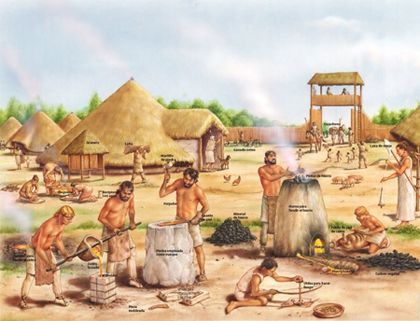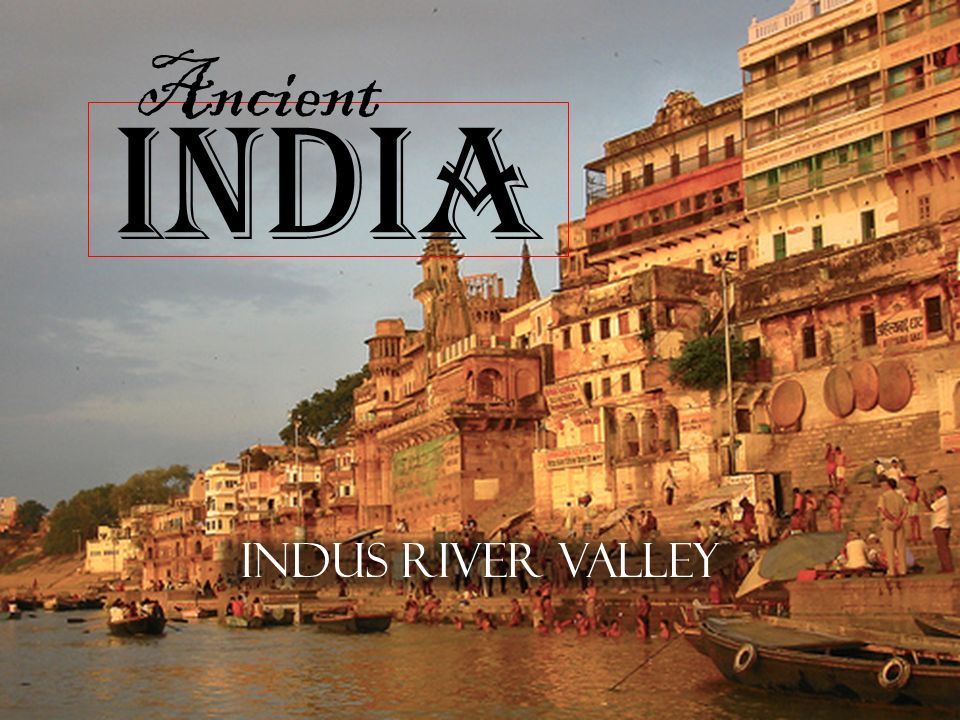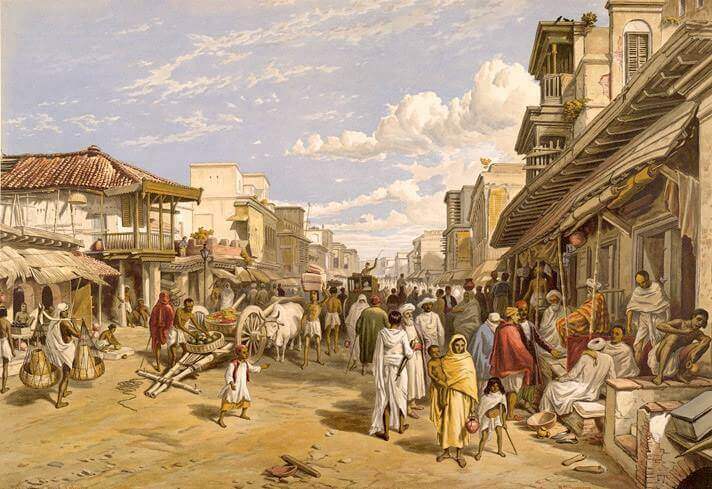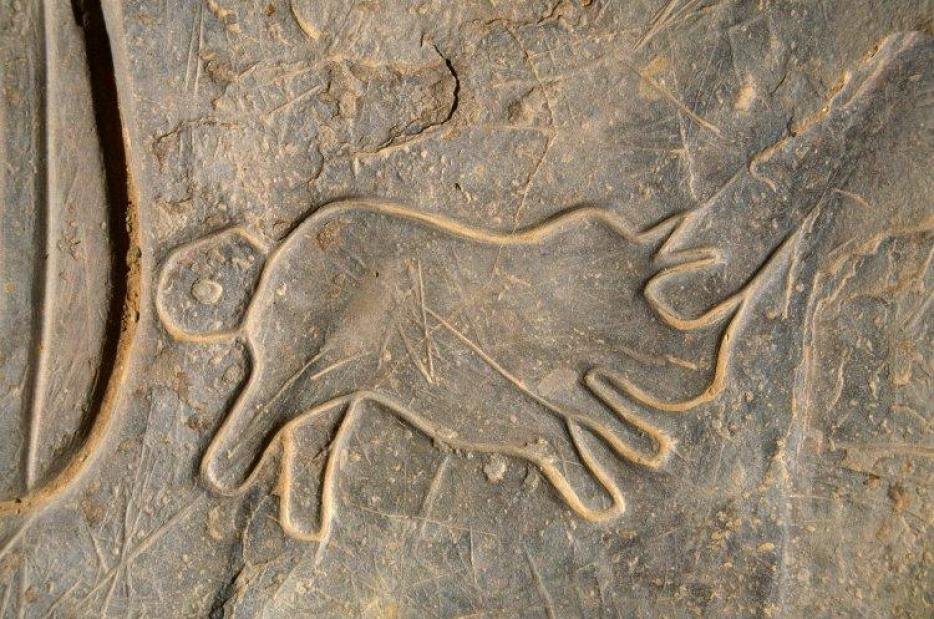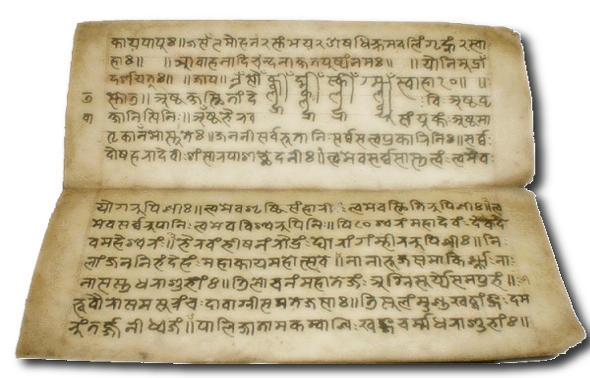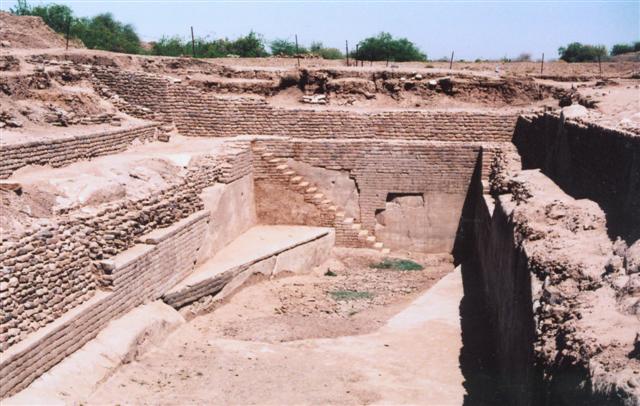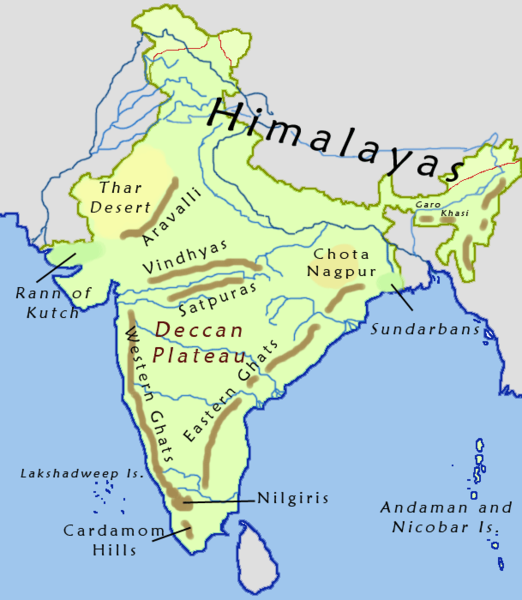- Home
- History of India
- Neolithic Age
Neolithic Age
New Stone Age Period
Neolithic age:
The term Neolithic is derived from the Greek word neo means ‘new’ and lithic means ‘stone’ which literally means new stone age. Neolithic age started around 10,000BC around the world but however in India it started around7,000BC.
The early important Neolithic sites in India are Bhirana in Haryana from 7570BC-6500BC, and in Mehargarh it was between 6500BC to 5500BC. However, in South India the Neolithic period was from 6500 BC to 1500 BC.
The predecessor of Neolithic age was Mesolithic age, and the successor of Neolithic age was Chalcolithic age. One can understand the evolution of history and reformation of the human beings from Paleolithic age to Chalcolithic age.
This period is also known as New Stone Age period. From Mesolithic age people started to settle at one place. In Neolithic age, new occupations started to develop. Animal husbandry, crop cultivation, pottery was among the new occupations that started.
Mehgarh situated in Baluchisthan is the only site belonging to this period. Other parts where Neolithic age remains are found in Kashmir valley, Cherand in Bihar, Belan valley in Uttar Pradesh in India.
People were no longer food gatherers, but they became food producer Food was produced in large quantity, this gave lot of free time to people living in Neolithic age. This made them to learn and invent new occupations especially related to arts.
As a result, section of people was able to improve on their talent of producing pots, baskets, carpentry etc. Since people in this age started to settle at one place, domestication of animals like cow, dog, and cat continued. Probably in this period when men used to go for hunting women would gather twigs plants and fruits from the forests.
The dog was probably the first animal to be tamed and domesticated. The semi nomadic life led to the formation of joint tribal life. When the grass field became impossible for supporting the cultivation, then use of spinning wheel, use of pottery, cotton woven into thread came into being. A large number of flint arrows heads, bone harpoons blades and sickles are found.
The change in economy made lifestyle from hunting-gathering to primitive farming called as Neolithic evolution. As agricultural products increased there came the necessity for storing the yields. With more perfection in agricultural techniques farmers were benefited with surplus grains which needed storage.
Hunter gatherers in Paleolithic age could not store food for long time due to migratory lifestyle, Neolithic people started to store food. This benefited Neolithic people during drought, flood etc. Slowly these crops were also exchanged with other communities marking the early beginning of trade. This period can be considered as one of the major turning point in the history of mankind and India as these were the first steps are the origin of:
- Living in communities
- Production and storage of agricultural/ farm produce
- Trade of goods among the communities
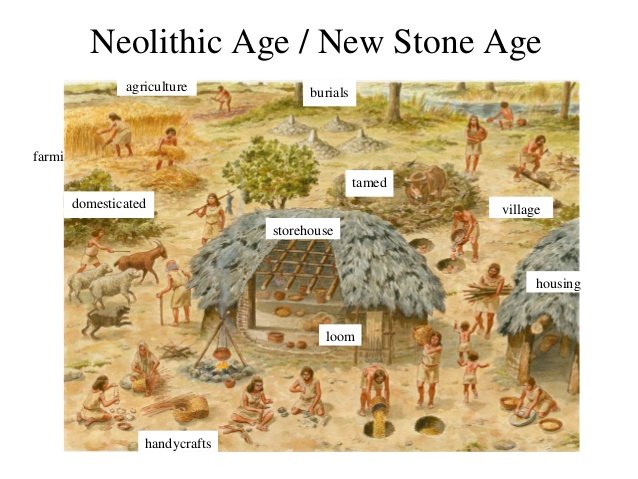
Agriculture during Neolithic age in India
Agriculture in Neolithic age:
People in Neolithic age were Food producers. Agriculture and animal domestication were the main activity during this period. They started growing crops like wheat, barley, horse gram, ragi and domestication of animals like dog, sheep and goat. The change for hunter gatherers to food producers can be termed as Neolithic revolution or agricultural revolution.
One of the important developments during the Neolithic period was making of pottery. Since excess of crops were grown it was required to store this excess food. This need led to the invention of pottery. With the advent of fire in Mesolithic period cooking had started. So, they made first pot by plastering clay round the baskets probably made of twigs/ wood or stone. These were hardened by heating them on fire.
Neolithic Sites in India
Neolithic people mostly lived closely near the river banks and hilly areas. Some of the important sites that are found in India are Mehargarh, Gufkral and Burzahom in Kashmir, Chirand in Bihar. The site in koldihwa shows the cultivation of rice around 6500BC.
.
Along with Koldihwa some other important sites in Uttar Pradesh are Mahgaro and Chopani Mando. The excavations of bones from Mahgaro and Chopani shows the domestications of animal like cattle, Sheep and goat.
Other important neolithic sites in northeastern part of India like Char Hills, Gharo Hills and Naga Hills have polished stones axes that were used during neolithic period. Other important sites in southern India are Kodekal, Paiyampalli in Tamil Nadu, Maski, Brahmagiri in Karnataka and Palavoy in Andhra Pradesh
Tools Used In Neolithic Age
Tools used in Neolithic Age:
Neolithic people were very highly skilled agriculturalists and also manufactured a wide range of tools that were required for doing agriculture, harvesting of crops and also for storing of excess crops produced. With new occupations coming into light, new tools were invented.
They continued to use flake implements made on flint, blade tools formed part of other heavy tools for example the blade tools were fitted into wooden handles to be used as awl, graver, saw, sickle etc.
Wet sandstone was used as abrasive. The tools in Neolithic period became more sophisticated and stronger. The new stone working technique were used for making tools including plane choppers, wedges and chisels.
All Neolithic tools like axes and adzes were having handles. A polished stone axe head of this period is commonly known as Celt. Bone tools became more prominent in Kashmir Neolithic sites. They were highly polished with sharp edges.
Some important changes in Neolithic pottery
One of the important developments during the Neolithic period was making of pottery. Since excess of crops were grown it was required to store this excess food. This need led to the invention of pottery.
With the advent of fire in Mesolithic period cooking had started. So, they made first pot by plastering clay round the baskets probably made of twigs/ wood or stone. These were hardened by heating them on fire.
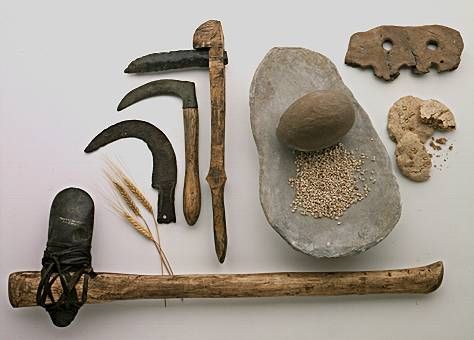
Houses in Neolithic Age:
The houses were rectangular in shape and built on a series of bamboo sticks with a conical roof of perishable material like thatch grass or reed. Usually stones and bricks were used to build houses. But the usage of material was largely dependent on the availability of the resources in local settings. In some places of Neolithic settlements a stone or brick built wall is found to encircle the houses, such stone or brick wall mainly protected them from wild animals. The need of the houses started to be felt once the people of this age stated to live for longer periods at one place, to store the excess food and for the security from the wild animals.
Burials in Neolithic Age:
To some extent even Neolithic people believed in life after death. Hence they buried the dead with food items, ornaments etc. Two different modes of disposal of dead can be noticed in this period such as Primary extended burials and Post excarnation burials.
Infants were buried in urns usually in the houses. In Kashmir valley the dead were buried in usually oval shaped pits dug into the house floors. These pits were narrow at the top and broad at the bottom. The sides of the pit were plastered with lime. Burials of wild dogs, cut marks suggests that there were proper sacrifices of animals.
Art in Neolithic Age
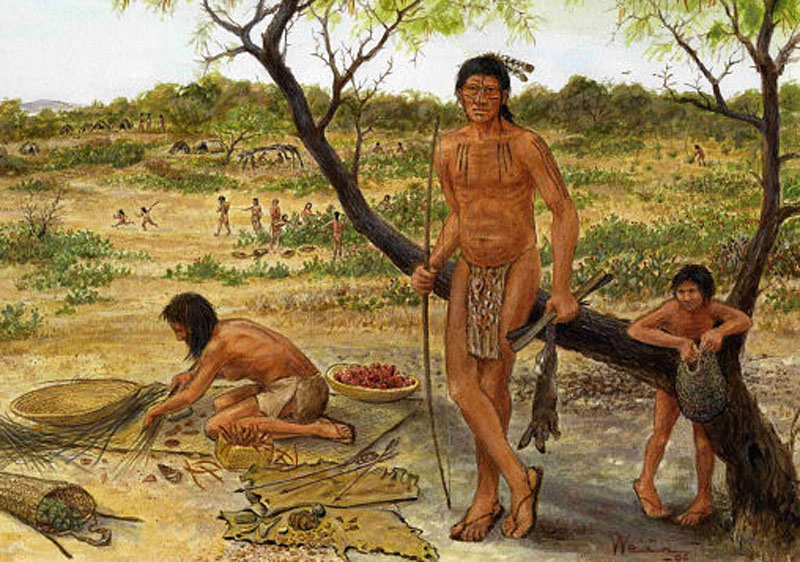
Art in Neolithic Age:
Another important development that took in Neolithic period was development of art. Paintings on caves and on the rock show their interest in art. This was obvious as the people of this age had their basic needs taken care and had extra time at their disposal hence the art prospered. Few terracotta figurines of bulls and birds are found at Piklihal, Tekkalkotta and Sanganakalli. At Burzagoan a stone slab is engraved with a hunting scene.
The Neolithic period is a very important period in human history. It shows the development of humans from hunter gatherer to food producers and permanent settlement. But however, during Neolithic period wide spread of diseases started like influenza, cholera. This could be because the people have started living in communities for the first time and perhaps, they didn’t realise the importance of sanitation and personal hygiene. However, the credit for present day village goes to Neolithic age.
Update on coronavirus in India
Affiliate Disclosure:
If you make any purchase via a link on this site, I may receive a small commission with no added cost to you.
